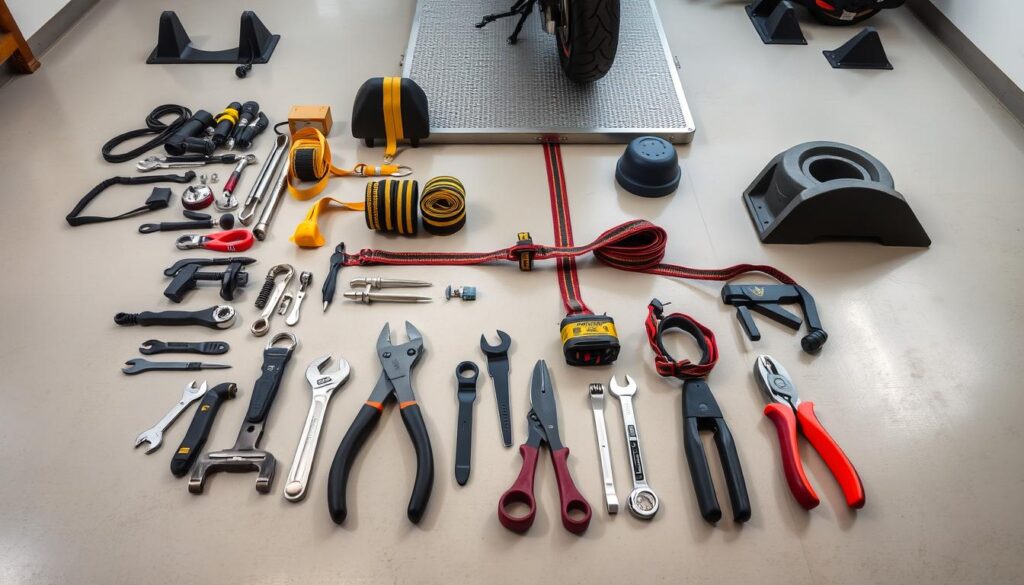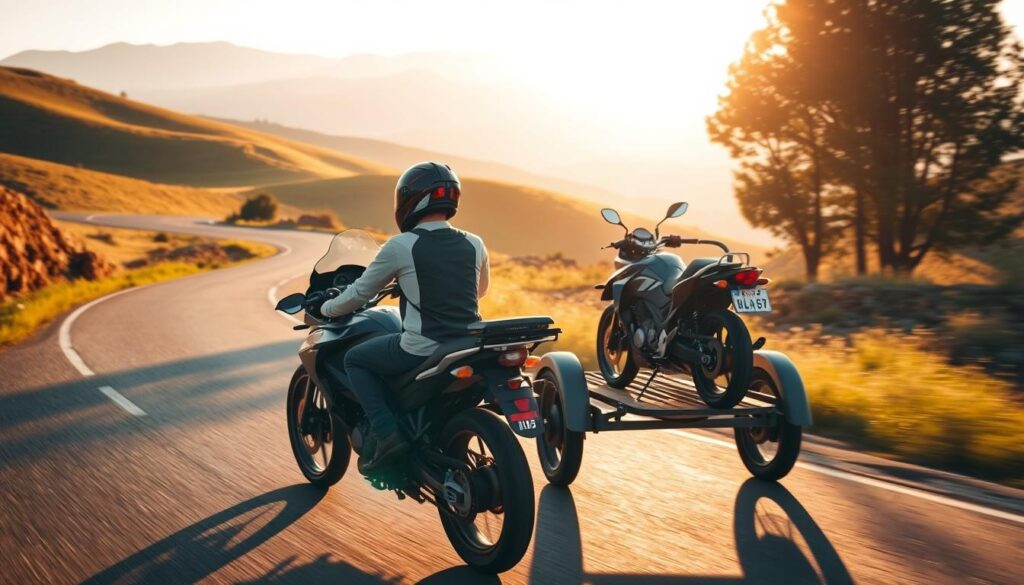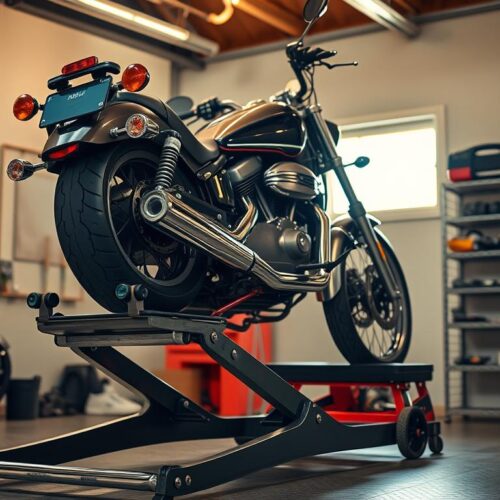Getting your motorcycle to your destination can often be smarter than riding it. This is especially true for family trips, rallies, or competition participation. A motorcycle trailer lets you bring your bike safely without adding miles to it. This guide teaches how to transport your motorcycle correctly. You’ll learn proper loading and what equipment you need. Follow along to find out how to easily transport your motorcycle.
1. Understanding Your Motorcycle Transport Needs
When thinking about motorcycle transport, it’s key to look at your needs. Transporting your bike might be needed for many things. It could be for fun road trips, track days, or contests. Knowing why you’re transporting your bike influences your choices.
First, think about what motorcycle you have. Different bikes need different transport ways. For example, a heavy cruiser needs a stronger trailer than a light sport bike. How far you need to move your bike is also important. Short trips might be easier, but long ones need more planning and gear.
How often you move your bike matters too. If you do it a lot, get a good trailer or a transport service. This keeps your bike safe and in good shape. Figuring out your transport needs helps pick the safest way to move your bike. Sort out your needs to make the process smoother and worry-free.
2. Choosing the Right Trailer for Your Motorcycle
Choosing the right trailer is essential when moving your motorcycle. Each trailer type offers unique advantages depending on your needs. Think about how much protection and convenience you want.
Open flatbed trailers are simple and affordable options for motorcycle transport. They make loading easy but don’t protect much from weather. They’re good if you’re watching your budget and moving over short distances.
Enclosed trailers, however, provide better security and shield your motorcycle from bad weather. They’re ideal for long journeys or when you need to store your bike for a while. Inside, you can also pack extra gear with your motorcycle.
Hitch carriers offer a compact and efficient way to transport smaller bikes or for shorter distances. They’re budget-friendly but check your vehicle’s weight capacity to avoid issues. Hitch carriers have limitations to keep in mind.
Knowing the differences between these trailers can help you pick one that fits your motorcycle, journey, and wallet. To compare these options side by side, look at the following table:
| Trailer Type | Advantages | Disadvantages |
|---|---|---|
| Open Flatbed | Cost-effective, easy loading | Limited protection |
| Enclosed | Enhanced security, weather protection | Higher cost |
| Hitch Carrier | Compact, quick transport | Weight limits, less storage space |
3. Preparing Your Motorcycle for Transport
Getting your motorcycle ready for a trip is important. Start by cleaning it well. This avoids scratches and lets you find any problems.
Checking fluids is next. Make sure oil, coolant, and brake fluid are full. This keeps your bike running smoothly on its journey.
Take off any loose parts. Things like mirrors and saddlebags can break if left on. Keep them safe by removing and packing them somewhere else.
Finally, look at your bike’s manual before you send it off. This will help make sure your motorcycle gets there without any issues.
4. Essential Tools and Equipment
When you’re moving your motorcycle, the right tools are key for safety and stability. High-quality tie-down straps are super important. People often use cam buckles and ratchet straps to keep motorcycles secure. These help you tighten your bike well, reducing any movement while you transport it.
A wheel chock boosts your motorcycle’s stability when it’s on the trailer. It keeps your bike from moving and falling. To avoid scratches, pair your tie-downs with soft straps. These protect the painted areas from damage.
Also, get locks for extra safety. Locks keep your motorcycle secure while on the trailer, especially during long trips or when parked. Make sure to have these essential tools and equipment for a hassle-free move.

5. Loading Your Motorcycle onto the Trailer
Loading your motorcycle onto the trailer is an important process. Doing it carefully helps avoid damage and keeps things safe. Here are some tips to make motorcycle loading easier:
- Use a quality ramp: Choose a strong ramp made for loading motorcycles. It ensures stability and makes getting onto the trailer easier.
- Engage the kickstand: Make sure the kickstand is down before you start. This stops the bike from tipping while you load.
- Balance your bike: Keep balanced by putting your weight on the bike. Pushing forward with your legs helps you guide it smoothly.
- Select the right gear: Gear up in first to control the bike better while loading. This stops it from rolling and keeps it stable.
- Practice loading techniques: Get to know the loading process before trying it. Practicing makes it easier and safer for you.
- Have a spotter: If you can, have someone help you. They can guide and support you through the loading.
Stick to these steps for a smooth and safe experience. These tips will lower the risk of accidents and keep your motorcycle secure for the trip.
6. Securing Your Motorcycle for Transport
It’s very important to secure your motorcycle well to avoid damage when transporting it. The top method is using effective motorcycle tie-down techniques to keep your bike stable. A four-point tie-down strategy is best for keeping your motorcycle steady and reducing shifts.
Don’t use the handlebars as the main points to tie down your motorcycle. This could cause damage and make it unstable. Instead, tie it down by the frame or special points made for this. Make sure to spread the tension evenly and not to pull the straps too tight to prevent stress on parts.
Always check how stable your motorcycle is before you start your trip. You can do this by gently shaking the bike to see if it moves. If you need to, adjust the straps to make sure everything is secure before you go.
7. Understanding Legal Requirements for Transport
Knowing the legal requirements for motorcycle transport is key. Each state has different rules for trailer registration, licensing, and insurance. Make sure to research your state’s laws before your trip. This ensures a smooth and legal journey.
Getting your trailer registered is usually necessary when moving a motorcycle. Make sure your trailer follows local laws and is registered right. This prevents problems during your trip. Licensing is also crucial; your driver’s license must cover your vehicle and trailer setup.
Insurance is essential for following motorcycle transport laws. Check that your motorcycle and trailer are both properly insured. This keeps you safe from legal issues while on the road. Also, knowing the correct way to load your motorcycle avoids legal troubles.
Always check local laws before you travel. State transportation departments can be great resources for the latest rules. Being well-informed and following the law makes for easy towing.
8. Driving with a Loaded Motorcycle Trailer
Drivng with a motorcycle trailer means you’ve got to be really careful. This is because there’s more weight and the trailer makes your ride longer. One big tip for towing a motorcycle trailer is to make wider turns. Since your setup is longer, tight turns could get you into trouble.
You’ll need to stop over longer distances because of the extra weight. It’s especially important to stretch those stopping times on wet roads. Always check your mirrors too. With a trailer on, you’ve got bigger blind spots, so keeping an eye out is key to stay safe.
Getting the weight right on your trailer is super important for a smooth ride. Make sure your bike is set up right in the middle over the trailer’s axles. If things aren’t balanced, your trailer might sway, and that’s risky. Before you hit the road, reviewing these towing motorcycle trailer tips is a smart move for a safe trip.

9. Unloading Your Motorcycle Safely
Unloading your motorcycle from a trailer needs careful attention to avoid accidents. It’s crucial to follow the right tips to ensure your safety and prevent damage to your bike.
First, make sure the ramp is stable. It should be on a flat surface and securely attached to the trailer. Having a friend help you can also make it safer.
Then, start loosening the tie-downs carefully. Make sure your bike is stable before removing the last tie-downs. This step is important to avoid any sudden falls.
When you’re ready to unload, take it slow. Gently guide your motorcycle down the ramp, keeping it balanced. Lean a bit forward to keep control as you go down.
Always keep an eye on your surroundings. This helps you avoid obstacles and makes sure your path is clear.
By taking these steps, you can safely and efficiently get your motorcycle off the trailer. This ensures a good start to your ride.
10. Maintenance Tips After Transporting
After your motorcycle arrives, check it well for any damage or signs of wear. This is important. Look for any leaks too, because securing the bike for transport might cause some.
It’s very important to check the tire pressure. Make sure the tires are pumped up right, following the maker’s guide. Doing this helps you avoid problems when riding.
Next, see if the suspension is working right. A good suspension means a smooth ride. Also, check the fairing for any damage from the transport.
Following these steps will help keep your bike in great shape. This means more fun rides in the future.
11. Transporting a Motorcycle Across State Lines
Moving your bike across state lines needs good planning. You must know each state’s rules about registration and insurance. This stops any legal issues during your interstate bike move.
For long trips, think about where you’ll stop to rest. It’s important to keep your motorcycle safe overnight. Choose accommodations that are welcoming to bikers and offer safe parking.
To help with your planning, here’s a table of key things to remember:
| Factor | Details |
|---|---|
| Registration Requirements | Check if your motorcycle registration is valid in the states you are visiting. |
| Insurance Coverage | Ensure your policy covers you in all states, as coverage can differ significantly. |
| Local Laws | Familiarize yourself with local laws regarding motorcycle riding and usage. |
| Stop Planning | Outline your route and include rest stops for fuel and food breaks. |
| Motorcycle Security | Secure your bike overnight with locks and chains when parking away from home. |
Following these steps helps make your motorcycle transport smoother. Being prepared improves your journey, whether it’s a long road trip or a short travel.
12. Conclusion: Ensuring a Safe Transport Experience
Getting your motorcycle from one place to another can be smooth and fun if you focus on safety first. Knowing what you need for the trip and picking the right trailer are key. It’s also important to get your motorcycle ready, use the necessary tools, and know the laws in your area.
In this guide, we’ve shared many tips for safely transporting your motorcycle. These include how to load, secure, and unload your bike correctly. Each step helps protect your motorcycle from harm as you travel.
Safe transport isn’t just about how you manage the bike. It also means understanding safe driving and what the law says. Following these tips lets you start your motorcycle journeys confidently. You’ll know you’ve done everything to keep your transport safe and secure.




